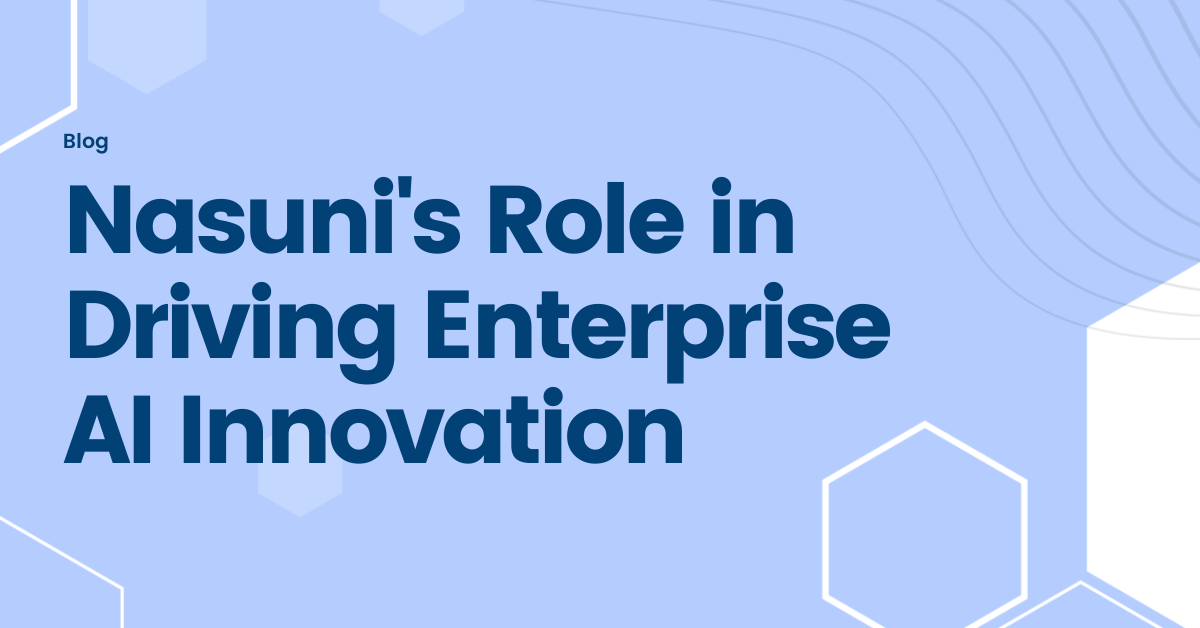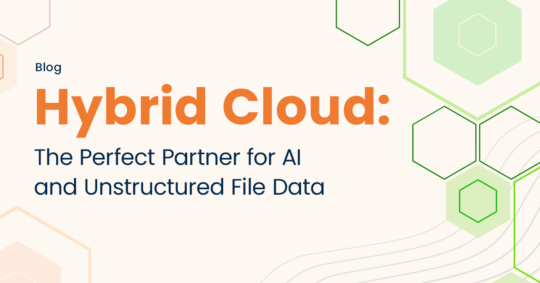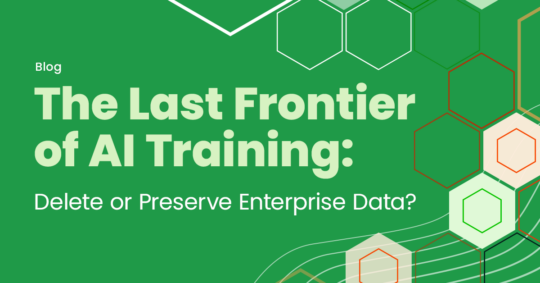Nasuni’s Role in Driving Enterprise AI Innovation
Senior Vice President of Product Nick Burling shares how Nasuni plays a critical role in driving enterprise AI innovation.
March 19, 2025 | Nick Burling

All the enterprise customers I’m talking to these days are dealing with the same challenge; The growing number of enterprise AI tools is making it harder and harder to pick the right solutions for their company, department, or team. In focusing on finding the next best model, however, many organizations are overlooking a critical step.
Whether you’re considering some variation of Claude, Copilot, or ChatGPT or an industry-specific AI tool, you need a complete view of the current and historical digital output of every office, studio, factory, warehouse, and remote site, involving every one of your employees. You need to consolidate, curate, and understand your data if you hope to get anything useful out of enterprise AI. This is one of the reasons the Nasuni platform is rapidly becoming an essential solution for our customers.
Garbage vs. Insight
Let’s say you’re managing AI adoption and strategy at a civil engineering firm. Your goal is to utilize GenAI to streamline the process of creating proposals. And you’ve heard everyone in the AI world boasting about how this is a perfect use case.
A typical civil engineering firm is going to have an incredibly broad range of files and complex models. Project data is going to be multimodal — a mix of text, video, images, and industry-specific files. Much of this data is going to be siloed on different systems in different locations. If you ask a standard GenAI tool to scan your enterprise data and produce a proposal, the result will likely be garbage.
Now consider the same scenario with the Nasuni File Data Platform. Your distributed mix of data will be consolidated, curated, and understood at a deeper level. Across tens of millions of files, you’ll have a sense of which groups own which files, who accesses them often, what file types are involved, and more. Assuming you have the appropriate security guardrails in place, you could choose a tool specifically tuned for proposals and securely give that tool access to only the relevant files within your organization.
The utility and probable success of the AI tool would increase because you’d be giving it access to a curated set of the right file data. You’d have something truly useful that helps your teams generate better, more relevant proposals faster.
The power of curation isn’t a new concept. Effective data curation is one of the drivers behind the incredible developments in AI and robotics. Robotic vehicles can rapidly identify and distinguish between trees and cars and people in large part because of a dataset called ImageNet. This collection contains more than 14 million images of common everyday objects that have been labeled by humans. Scientists trained the object recognition algorithms running inside self-driving cars on this data because it was curated. They knew exactly what they had.
Data Challenges & AI Limits
Even with curation, however, there can be challenges. Let’s say a project manager (PM) overseeing multiple construction sites wants to use a large language model (LLM) to automatically analyze daily inspection reports. At first glance, this would seem to be a perfect use case, as the PM would be working with a very specific set of files. In reality, though, the reports would probably come in different formats, ranging from spreadsheets to PDFs and handwritten notes. The dataset might include checklists or different phrasings representing the same idea.
A human would easily recognize this collected data as variations of a site inspection report, but a general-purpose LLM would not have that kind of world or industry knowledge. A tool like this would likely generate inaccurate and confusing results. In this case, Nasuni would help the PM recognize early that the complexity and variation in the inspection reports would lead to challenges, saving the organization the expense and trouble of investing in an AI tool for this application.
Your Data is Increasing in Value
Consolidating and curating your data is also going to empower you to do more with that data. Since most of your organization’s data resides within your security perimeter, no AI model has trained on those files. That means you have a completely unique dataset that has not yet been mined for insights. You could take the capabilities the general AI models developed in training on massive, general datasets and (with the right security framework in place) fine-tune them on your organization’s unique gold mine of enterprise data.
This is already happening at an industry scale. The virtual paralegal Harvey has been fine-tuned on curated legal data, including case law, statutes, contracts, legal briefs, and the rest. BioBERT, a model optimized for medical research, was trained on a curated dataset of biomedical texts. The researchers who developed this tool did so because biomedical texts have such a particular or specific language.
One Constant in the Model Madness
Whether you want to embark on an ambitious project to create a fine-tuned model or select the right existing tool for a department or project team’s needs, it all starts with data curation. And that is because the one constant in all this model madness is that if you don’t know what sort of data you have, you are not going to know how to use it.
Related resources

White paper
Transforming Unstructured Data Chaos into AI Order
A robust data strategy is crucial for AI adoption in businesses. This whitepaper offers a framework to centralize data, ensuring validity and security for…
Learn more
March 12, 2025 | Jim Liddle
Hybrid Cloud: The Perfect Partner for AI and Unstructured File Data
Nasuni’s Jim Liddle discusses how enterprises need to leverage hybrid cloud solutions like Nasuni to prepare their unstructured data for AI.
Read more
February 19, 2025 | Jim Liddle
The Last Frontier of AI Training: Delete or Preserve Enterprise Data?
Nasuni Chief Innovation Officer Jim Liddle discusses the debate of whether IT teams should delete or preserve historical enterprise data.
Read more
White paper
Transforming Unstructured Data Chaos into AI Order
A robust data strategy is crucial for AI adoption in businesses. This whitepaper offers a framework to centralize data, ensuring validity and security for…
Learn more
March 12, 2025 | Jim Liddle
Hybrid Cloud: The Perfect Partner for AI and Unstructured File Data
Nasuni’s Jim Liddle discusses how enterprises need to leverage hybrid cloud solutions like Nasuni to prepare their unstructured data for AI.
Read more
February 19, 2025 | Jim Liddle
The Last Frontier of AI Training: Delete or Preserve Enterprise Data?
Nasuni Chief Innovation Officer Jim Liddle discusses the debate of whether IT teams should delete or preserve historical enterprise data.
Read more
White paper
Transforming Unstructured Data Chaos into AI Order
A robust data strategy is crucial for AI adoption in businesses. This whitepaper offers a framework to centralize data, ensuring validity and security for…
Learn more
March 12, 2025 | Jim Liddle
Hybrid Cloud: The Perfect Partner for AI and Unstructured File Data
Nasuni’s Jim Liddle discusses how enterprises need to leverage hybrid cloud solutions like Nasuni to prepare their unstructured data for AI.
Read more
February 19, 2025 | Jim Liddle
The Last Frontier of AI Training: Delete or Preserve Enterprise Data?
Nasuni Chief Innovation Officer Jim Liddle discusses the debate of whether IT teams should delete or preserve historical enterprise data.
Read more